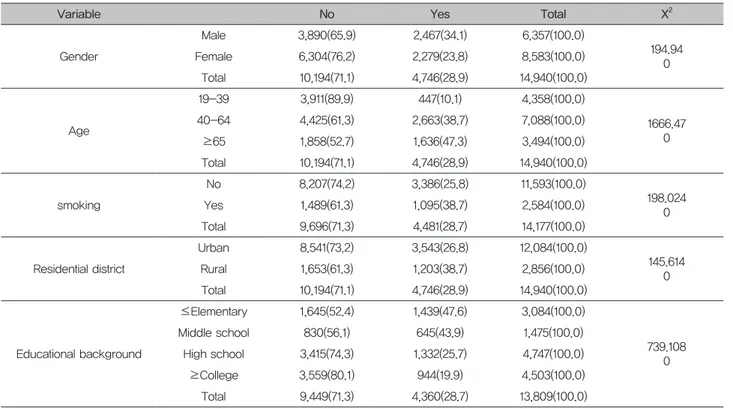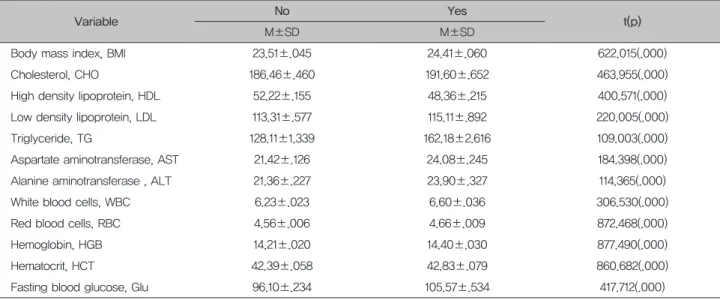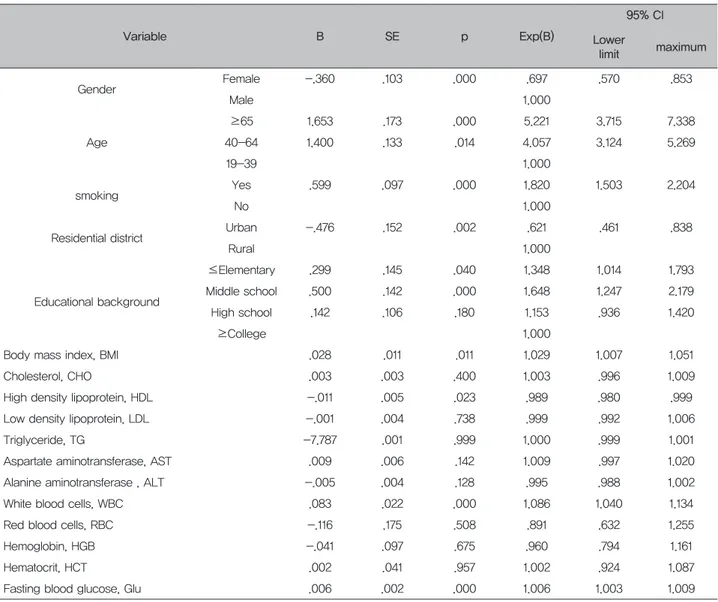http://doi.org/10.14347/kadt.2019.41.2.103
한국 성인의 치주질환 유병과 체질량지수 및 임상검사요인의 관련성 연구 국민건강영양조사 제6기 조사자료
김병식, 이종화
수성대학교 치기공과A study on the relationships between periodontal diseases, body mass index and clinical factors for Korean adults
Byung-Sik Kim, Jong-Hwa Lee
Department of Dental Laboratory Technology, Suseong University
[Abstract]
Purpose: This article tried to find the relations between periodontal diseases, body mass index and clinical level for Korean adults over the age of 19, utilizing data of the 6th national nutrition survey.
Methods: In the collected data, 14,940 adults aged 19 years or older were included in the study to determine the relationship between the general health status of Korean adults and periodontal disease.
Results: As the result, 28.6% of Korean adults had periodontal diseases, there were significant differences depending on gender, age, smoking, residential aria, education level, body mass index, HDL-cholesterol, leukocyte value and fasting blood sugar. When general factors were controlled for multiple logistic regression analysis, there was significance as BMI cross rate was 1.029(95% C1, 1.007-1.051). HDL-cholesterol cross rate was 0.989(95% C1, 0.980-0.999), leukocyte cross rate was 1.086(95% C1, 1.040-1.134) and fasting bloody sugar cross rate was 1.006(95% C1, 1.003-1.009), so there were significance.
In conclusion, there was a significance relation between periodontal diseases, body mass index, HDL-cholesterol and fasting bloody sugar.
Conclusion: Based on the results of this study, oral health education should be used to manage and maintain healthy oral cavity by improving periodontal disease management and awareness. In addition, it will be necessary to develop periodic oral examinations and age - specific oral health education programs, and it can be used as a basic data for public oral health plan.
Key words: Clinical examination, BMI, Ministry of Health and Welfare, Periodontal disease, The Fifth Korea National Health and Nutrition Examination Survey
Corresponding author
Name
이 종 화Tel.
053-749-7253Address
대구 수성구 달구벌대로 528길 15 수성대학교 치기공과I. 서 론
의료기술의 발전으로 인류는 기대수명이 증가하고 있 으며, 삶의 질은 높아지고 있다(Kim et al, 2015). 기본 적으로 삶의 질을 높이고 장수하기 위해서는 의식주의 해결과 더불어 전신건강이 우선되어야 하는데, 이러한 전신건강에 필수적인 것이 구강건강에서부터 비롯된다 고 할 수 있다(Migliorati & Madrid, 2007; Tsakos et al. 2006). 한국에서 구강건강 상태의 평가를 위한 객관 적 지표로는 우식경험영구치(decayed, missing, and filled teeth: DMFT)와 지역사회치주지수(community periodontal index: CPI) 등의 지표를 이용한다. 그 가 운데 지역사회치주지수(CPI)로 측정되는 치주질환은 치아우식증과 더불어 구강 내에 발병하는 대표적 만성 질환(Burt & Position, 2005)이며, 치면세균막에 의 해 발생되는 치아주위조직의 만성적인 염증성 질환으 로 치주낭 형성과 치은 퇴축을 비롯한 치주인대, 치 조골 파괴 등의 변화가 일어난다(Korean council for periodontology professor, 2010). 치주질환의 원인은 미흡한 구강건강관리, 치석 및 기타 국소원인들과 영양 상태의 이상, 내분비계의 장애, 전신질환, 약물복용, 흡 연, 고령화 등과 같은 전신적 원인 등에 의해 영향을 받 는다(Holtfreter et al. 2010; Kim & Jang, 2015).
특히, 전신질환이 있는 경우 관상동맥환자에게서 상 실치아 수와 치태지수의 관련성이 보고(Loesche et al, 1998)되었고, 급성 심근경색 환자의 경우 탐침 시 출 혈 빈도가 높다고 하였다(Emingil et al, 2000). 이처 럼 전신질환과 깊은 관련성이 있는 치주질환을 평가 하는 기준인 치주낭 깊이가 4 mm 이상은 35세-44 세에서 29.8%, 45세-54세에서 46.4%, 55세-64세 57%로 치주질환 유병률은 지속적으로 증가하고 있고 (Ministry of Health & Welfare, 2010) 35세 이상의 성인에게 있어 치아상실의 주된 원인으로 알려져 있으 며(Ministry of Health & Welfare, 2010). 만19세 이상 성인의 26.8%가 치주질환이 있다고 보고하였다(Han et al. 2013). 미국의 경우 치주질환 유병률은 30세 이 상 성인 47.2%가 치주질환을 가지고 있는 것으로 보고 하였으며(Thornton-Evans et al. 2013), 독일은 치주
인에서 95.0%로 보고하여(Holtfreter et al. 2010), 치 주질환의 유병률은 연령이 증가할수록 높아지고 있다 고 하였다(Petersen & Ogawa, 2005). 치주질환은 초 기에 자각 증상이 없어서 예방과 조기발견, 조기치료가 중요한데(Morrison et al. 1982) 최근 치주질환의 위험 요인에 대한 선행연구들은 흡연, 비만, 만성폐쇄성폐질 환, 당뇨병 등과 관련성이 있다고 보고되었다(Jung et al, 2010; Won & Ha, 2014; Lee & Park, 2013; Jin, et al, 2013). 또한 치주질환과 인구·사회경제적 수준, 구강건강행위, 구강관련 삶의 질 등과 관련성 연구를 보 고하였지만(Jung & Oh, 2011; Choi et al, 2010; Woo et al, 2013), 이러한 선행연구들은 주로 일부 요인에 대 한 단일 질환과 행태 등 치주질환과의 관련성만을 살펴 본 연구들이 대부분이며, 한국 성인의 치주질환 위험요 인에 대한 객관적인 임상 검사 수치요인들을 고려한 연 구는 부족한 실정이다.
따라서 본 연구는 한국의 대표성과 신뢰성을 갖춘 통 계자료(Jung & Oh, 2011; Choi et al, 2010; Woo et al, 2013)를 바탕으로 한국성인의 전신질환과 관련된 체 질량지수를 비롯한 임상검사 수치 변수들이 치주질환과 어떠한 관련성을 있는지 알아보고, 한국성인의 구강건 강증진을 위한 기초자료를 제공하고자 실시하였다.
Ⅱ. 연구 방법 1. 연구 대상
본 연구는 국민건강영양조사 제6기 제 1차 년도
(Ministry of Health & Welfare, 2013), 제 2차 년도
(Ministry of Health & Welfare, 2014), 제 3차 년도
(Ministry of Health & Welfare, 2015) 자료를 이용하
였다. 이러한 제6기 자료조사는 2013년, 2014년, 2015
년 각 년도별 1월부터 12월까지 전국 시·도, 동·읍면,
주택유형(일반주택, 아파트)을 기준으로 추출틀을 층화
하고, 주거면적 비율, 가구주 학력 비율 등을 내재적 층
화 기준으로 사용하였다. 표본 조사구는 연간 192개, 3
년간 576개를 추출하였으며, 표본 조사구 내에서 양로 원, 군대, 교도소, 등의 시설 및 외국인 가구 등을 제외 한 적절기구 중 계통추출법을 이용하여 20개 표본가구 를 선정하였다. 표본가구 내에서는 적정가구원 요건을 만족하는 만 1세 이상의 모든 가구원을 조사대상자로 수집된 자료에서 한국 성인의 전신건강상태와 치주질환 과의 관련성을 파악하기 위해 만19세 이상 성인 14,940 명을 연구에 포함하여 분석하였다.
2. 조사도구와 내용
본 연구에서 사용된 국민건강영양조사 제6기 자료는 건강 설문조사, 검진조사, 영양조사, 구강검사(검진조 사) 등으로 이루어져 있다. 본 연구에 사용된 변수로 일 반적 특성은 성별, 연령, 지역, 교육수준 등을 사용하 였고, 건강행태 변수는 흡연과 체질량지수(Body Mass Index, BMI) 등을 사용하였으며, 구강검사(검진조사) 변수는 치주질환 유병여부를 사용하였다. 성별은 남자, 여자로 구분하였고, 연령은 19-39세, 40-64세, 65세 이상으로 구분하였다. 지역은 대도시, 농어촌으로 구분
하였으며, 교육수준은 초등학교 졸업, 중학교 졸업, 고 등학교 졸업, 대학교 이상으로 구분하였다.
임상검사 수치에 대한 변수로는 총콜레스테롤 (Cholesterol, CHO), 고밀도 지질단백질(High density lipoprotein, HDL), 저밀도 지질단백질(Low density lipoprotein, LDL), 중성지방(Triglyceride, TG), 간세 포효소(Aspartate aminotransferase, AST), 알라닌 아미노전이효소(Alanine aminotransferase , ALT), 백혈구(White blood cells, WBC), 적혈구 (Red blood cells, RBC), 헤모글로빈 (Hemoglobin, HGB), 적혈구 용적률(Hematocrit, HCT), 공복혈당(Fasting blood glucose, Glu) 등을 사용하였다.
3. 자료처리 및 분석 방법
본 연구의 통계적 분석은 통계분석용 소프트웨어인 SPSS(SPSS 21.0 for Windows, SPSS Inc, USA)를 이용하였다. 국민건강영양조사 제6기 자료를 통합하 여, 복합표본 요소를 고려하기 위해 층(분산추정층), 집 락(조사구) 및 분석변수 관련 조사부문·영역·항목 등
Table 1. General feature depending on periodontal diseases (Unit N(%)
Variable No Yes Total X2
Gender
Male 3,890(65.9) 2,467(34.1) 6,357(100.0)
194.94 Female 6,304(76.2) 2,279(23.8) 8,583(100.0) 0
Total 10,194(71.1) 4,746(28.9) 14,940(100.0)
Age
19-39 3,911(89.9) 447(10.1) 4,358(100.0)
1666.47 0
40-64 4,425(61.3) 2,663(38.7) 7,088(100.0)
≥65 1,858(52.7) 1,636(47.3) 3,494(100.0)
Total 10,194(71.1) 4,746(28.9) 14,940(100.0)
smoking
No 8,207(74.2) 3,386(25.8) 11,593(100.0)
198.024
Yes 1,489(61.3) 1,095(38.7) 2,584(100.0) 0
Total 9,696(71.3) 4,481(28.7) 14,177(100.0)
Residential district
Urban 8,541(73.2) 3,543(26.8) 12,084(100.0)
145.614 Rural 1,653(61.3) 1,203(38.7) 2,856(100.0) 0
Total 10,194(71.1) 4,746(28.9) 14,940(100.0)
Educational background
≤Elementary 1,645(52.4) 1,439(47.6) 3,084(100.0)
739.108 0 Middle school 830(56.1) 645(43.9) 1,475(100.0)
High school 3,415(74.3) 1,332(25.7) 4,747(100.0)
≥College 3,559(80.1) 944(19.9) 4,503(100.0)
Total 9,449(71.3) 4,360(28.7) 13,809(100.0)
합표본설계(complex sampling design) 다단계 층화·
집락·확률추출방법으로 추출하여 분석계획파일을 생 성하였고, 치주질환 유무(있음=1, 없음=0)을 부모집단 (Subpopulation)으로 지정하여 분석 결과에 사용하였 다. 생성된 분석 자료의 결측값 처리는 “사용자 결측값 이 유효함”으로 처리하여 분석변수에 결측이 있는 자료 도 포함하였으며, 이는 추정치의 분산에만 영향을 주기 때문에 자료분석 시 모두 적용하였다. 조사된 자료의 특 성에 따라 일반적 특성과 치주질환 유무는 복합표본 교 차분석을 하였고, 치주질환 유무에 따른 체질량지수와 임상검사와의 차이는 독립표본 t-검정을 분석하였고, 일반적 특성을 비롯한 체질량지수 및 임상검사와 치주 질환 유병여부의 관련성을 알아보기 위해서는 복합표본 로지스틱 회귀분석을 이용하였다. 통계적 유의성 판정 을 위한 유의수준(significance level)은 0.05로 고려하 였다.
Ⅲ. 결 과
1. 치주질환 유무에 따른 일반적 특성
연구대상자의 치주질환 유무에 따른 일반적 특성을 살펴보면 (Table 1), ‘치주질환 있음’에서 성별은 ‘남자’
령에서는 ‘65세 이상’은 47.3%로 가장 높았고, ‘40-64 세’가 38.7%, ‘19-39세’ 10.1% 순으로 나타났고 통계적 으로 유의하였다(p<0.001). 흡연상태는 ‘피우는 경우’는 38.7%, ‘피우지 않는 경우’가 25.8%의 분포를 보였으며 (p<0.001), 지역은 ‘농촌’ 38.7%, ‘도시’ 26.8%로 나타났 고(p<0.001), 교육수준에서는 ‘초졸 이하’ 47.6%, ‘중졸’
43.9%, ‘고졸’ 25.7%, ‘대졸이상’ 19.9% 순으로 나타나 통계적으로 유의하였다(p<0.001).
2. 치주질환 유무에 따른 체질량지수와 임상검사 비교
치주질환 유무에 따른 체질량지수와 임상검사 수치를 t-test로 분석한 결과는 (Table 2)와 같다. 체질량지수 (BMI)은 ‘치주질환이 있는 경우’ 24.41보다 ‘치주질환이 없는 경우’가 23.51로 유의하게 낮게 나타났고, 총콜레 스테롤(CHO)에서는 ‘치주질환이 있는 경우’ 191.60보다
‘치주질환이 없는 경우’가 191.60으로 유의하게 낮게 나 타났다(p<0.001). 이상지질혈증검사 항목 중 고밀도 지 질단백질(HDL)에서 ‘치주질환이 있는 경우’ 48.36㎖/㎗
보다 ‘치주질환이 없는 경우’가 52.22㎖/㎗로 유의하게 높게 나타났고, 저밀도 지질단백질(LDL)에서 ‘치주질환 이 있는 경우’ 115.11㎖/㎗보다 ‘치주질환이 없는 경우’
가 113.31㎖/㎗로 유의하게 낮게 나타났다(p<0.001). 중
Table 2. Comparing body mass index with clinical testing depending on periodontal diseases
Variable No Yes
M±SD M±SD t(p)
Body mass index, BMI 23.51±.045 24.41±.060 622.015(.000)
Cholesterol, CHO 186.46±.460 191.60±.652 463.955(.000)
High density lipoprotein, HDL 52.22±.155 48.36±.215 400.571(.000)
Low density lipoprotein, LDL 113.31±.577 115.11±.892 220.005(.000)
Triglyceride, TG 128.11±1.339 162.18±2.616 109.003(.000)
Aspartate aminotransferase, AST 21.42±.126 24.08±.245 184.398(.000)
Alanine aminotransferase , ALT 21.36±.227 23.90±.327 114.365(.000)
White blood cells, WBC 6.23±.023 6.60±.036 306.530(.000)
Red blood cells, RBC 4.56±.006 4.66±.009 872.468(.000)
Hemoglobin, HGB 14.21±.020 14.40±.030 877.490(.000)
Hematocrit, HCT 42.39±.058 42.83±.079 860.682(.000)
성지방(TG)에서는 ‘치주질환이 있는 경우’ 162.18㎖/㎗
보다 ‘치주질환이 없는 경우’가 128.11㎖/㎗로 유의하게 낮게 나타났다(p<0.001). 혈액 간기능 검사상 간세포효 소 AST(GOT)에서는 ‘치주질환이 있는 경우’ 24.08㎖/
㎗보다 ‘치주질환이 없는 경우’가 21.42㎖/㎗로 유의하 게 낮게 나타났고, 알라닌 아미노전이효소 ALT(GPT) 에서는 ‘치주질환이 있는 경우’ 23.90㎖/㎗보다 ‘치주질 환이 없는 경우’가 21.36㎖/㎗로 유의하게 낮게 나타났 다(p<0.001). 백혈구(WBC)에서는 ‘치주질환이 있는 경 우’ 6.60㎖/㎗보다 ‘치주질환이 없는 경우’가 6.23㎖/㎗
로 유의하게 낮게 나타났고, 적혈구(RBC)에서는 ‘치주 질환이 있는 경우’ 4.66㎖/㎗보다 ‘치주질환이 없는 경 우’가 4.66㎖/㎗로 유의하게 낮게 나타났다. 헤모글로 빈(HGB)에서는 ‘치주질환이 있는 경우’ 14.40㎖/㎗보다
‘치주질환이 없는 경우’가 14.21㎖/㎗로 유의하게 낮게 나타났고, 적혈구 용적률(HCT)에서는 ‘치주질환이 있는 경우’ 42.83㎖/㎗보다 ‘치주질환이 없는 경우’가 42.39
㎖/㎗로 유의하게 낮게 나타났으며, 공복혈당(Glu)에서 는 ‘치주질환이 있는 경우’ 105.57㎖/㎗보다 ‘치주질환 이 없는 경우’가 96.10㎖/㎗로 유의하게 낮게 나타났다.
3. 치주질환 유무에 따른 체질량지수와 임상검사 비교
일반적 특성과 체질량지수 및 임상검사요인과 치주질 환의 관련성을 알아보기 위한 복합표본 로지스틱 회귀 분석 결과는 (Table 3)과 같다. 치주질환과의 관련성이 있는 변수로는 성별, 연령, 흡연여부, 지역, 교육수준,
Table 3. Relations between general feature and body mass index, clinical factors and periodontal diseases
Variable B SE p Exp(B)
95% CI Lower
limit maximum
Gender Female -.360 .103 .000 .697 .570 .853
Male 1.000
Age
≥65 1.653 .173 .000 5.221 3.715 7.338
40-64 1.400 .133 .014 4.057 3.124 5.269
19-39 1.000
smoking Yes .599 .097 .000 1.820 1.503 2.204
No 1.000
Residential district Urban -.476 .152 .002 .621 .461 .838
Rural 1.000
Educational background
≤Elementary .299 .145 .040 1.348 1.014 1.793
Middle school .500 .142 .000 1.648 1.247 2.179
High school .142 .106 .180 1.153 .936 1.420
≥College 1.000
Body mass index, BMI .028 .011 .011 1.029 1.007 1.051
Cholesterol, CHO .003 .003 .400 1.003 .996 1.009
High density lipoprotein, HDL -.011 .005 .023 .989 .980 .999
Low density lipoprotein, LDL -.001 .004 .738 .999 .992 1.006
Triglyceride, TG -7.787 .001 .999 1.000 .999 1.001
Aspartate aminotransferase, AST .009 .006 .142 1.009 .997 1.020
Alanine aminotransferase , ALT -.005 .004 .128 .995 .988 1.002
White blood cells, WBC .083 .022 .000 1.086 1.040 1.134
Red blood cells, RBC -.116 .175 .508 .891 .632 1.255
Hemoglobin, HGB -.041 .097 .675 .960 .794 1.161
Hematocrit, HCT .002 .041 .957 1.002 .924 1.087
Fasting blood glucose, Glu .006 .002 .000 1.006 1.003 1.009


